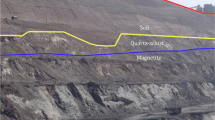In this study, an unstable rock slope has been investigated. To evaluate the stability of the pentahedral rock wedge with multi-slip surfaces, an approach based on the limit equilibrium method has been used. The slope has been divided into two parts for the establishment of the model: an upper wedge block and a lower pentahedron block. Namely, a three-dimensional space problem can be resolved into a local equilibrium problem of several sub-blocks. Then, the geometric parameters can be determined, and the mechanical analysis can be carried out. Finally, the minimum safety factor can be calculated by using the optimization method. This proposed approach has been applied to analyze the stability of the unstable rock slope before and after reservoir impoundment. The results show that the safety factor is significantly smaller after reservoir impoundment. The safety factor can meet the safety control standards of specifications without considering the extreme conditions of combined rainstorm and seismic force under the proposed reservoir water level.
Similar content being viewed by others
References
R. E. Goodman, “Thirty-fifth Rankine lecture: block theory and its application,” Geotechnique, 45(3), 383-423 (1995).
F. S. Jeng, T. L. Chiang, and M. L. Lin, “Analysis of the kinematic stability of pyramidal blocks,” J. Rock Mech. Min. Sci., 41(3), 384-389 (2004).
Y. J. Wang, J. H. Yin, Z. Chen, and C. F. Lee, “Analysis of wedge stability using different methods,” Rock Mech. Rock Eng., 37(2), 127-150 (2004).
R. Jimenez-Rodriguez and N. Sitar, "Rock Wedge Stability Analysis Using System Reliability Methods," Rock Mech. Rock Eng., 40(4), 419-427 (2007).
P. F. Mccombie, “Displacement based multiple wedge slope stability analysis,” Comput. Geotech., 36(1), 332-341 (2009).
H. Kumsar, O. Aydan, and R. Ulusay, “Dynamic and static stability assessment of rock slopes against wedge failures,” Rock Mech. Rock Eng., 33(1), 31-51 (2000).
W. Wittke, “Influence of the shear strength of the joints on the design of prestressed anchors to stabilize a rock slope," Geotechnical Conference, Oslo, Paper No. 4.11, 311-318 (1967).
K. Kovari and P. Fritz, "Stability analysis of rock slopes for plane and wedge failure with the aid of a programmable pocket calculator," 16th US Rock Mech. Symp., Minneapolis, USA, 25-33 (1975).
E. Hoek, J. W. Bray, and J. M. Boyd, "The stability of a rock slope containing a wedge resting on two intersecting discontinuities," J. Eng. Geol. Hydrogeol., 6(1), 1-55 (1973).
K. W. John, "Graphical stability analysis of slopes in jointed rock," J. Soil Mech. Found Div., 94(2), 497-526 (1968).
P. Londe, G. Vigier, and R. Vormeringer, "Stability of rock slopes, a three-dimensional study," J. Soil Mech. Found Div., 95(1), 235-62 (1969).
E. Hoek and J. W. Bray, Rock Slope Engineering, Institute of Mining and Metallurgy, New York (1977).
A. J. Hendron, E. J. Cording, and A. K. Aiyer, “Analytical and graphical methods for the analysis of slopes in Rock masses,” Technical Report GL-80-2, US Army Engineers Nuclear Cratering Group, Livermore, CA (1980).
P. M. Warburton, “Vector stability analysis of an arbitrary polyhedral rock block with any number of free faces,” Int. J. Rock Mech. Miner., 18 (5), 415-27 (1981).
S. D. Priest, Hemispherical Projection Methods in Rock Mechanics, George Allan & Unwin, London (1985).
R. E. Goodman and G. H. Shi, Block Theory and Its Application to Rock Engineering, Prentice-Hall, 1(1), 103-105 (1985).
H. C. Chan and H. H. Einstein, “Approach to complete limit equilibrium analysis for rock wedges - the method of “artificial supports,” Rock Mech., 14 (2), 59-86 (1981).
M. Mauldon and R. E. Goodman, “Vector analysis of keyblock rotation,” J. Geotech. Geoenviron. Eng., 122(12), 976-87 (1996).
F. Tonon, “Generalization of Mauldon’s and Goodman's analysis of keyblock rotations,” J. Geotech. Geoenviron. Eng., 124 (10), 913-22 (1998).
Author information
Authors and Affiliations
Corresponding author
Additional information
Translated from Osnovaniya, Fundamenty i Mekhanika Gruntov, No. 2, p. 14, March-April, 2021.
Rights and permissions
About this article
Cite this article
Ren, G.M., Xia, M., Yang, X.L. et al. Stability Analysis of a Pentahedral Rock Wedge Governed by Multi-Discontinuities. Soil Mech Found Eng 58, 138–145 (2021). https://doi.org/10.1007/s11204-021-09718-y
Published:
Issue Date:
DOI: https://doi.org/10.1007/s11204-021-09718-y




